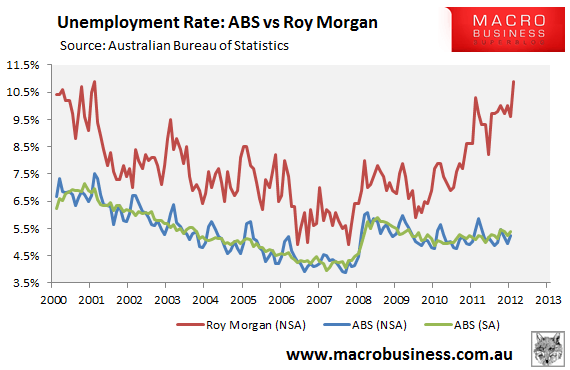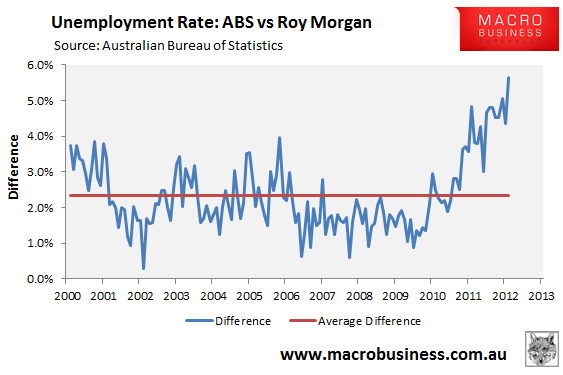
Later this morning, the Australian Bureau of Statistics (ABS) will release the official labour force data for the month of January. As noted yesterday by Houses and Holes, the unofficial provider of Australian labour force statistics, Roy Morgan Research, released its unemployment estimate, which showed unemployment surging by 1.3% over the month to 10.9%.
Part of this surge in unemployment was due to seasonality: Roy Morgan unemployment figures always skyrocket in January because the series is not seasonally adjusted and school leavers join the work force. Then it falls through then first half as they find jobs. Nevertheless, the jump was a little larger than usual this year, as evident by Roy Morgan unemployment hitting its highest level in 11 years.
As explained previously, Roy Morgan Research also measures employment differently from the ABS:
According to the ABS definition, a person who has worked for one hour or more for payment or someone who has worked without pay in a family business, is considered employed regardless of whether they consider themselves employed or not.
The ABS definition also details that if a respondent is not actively looking for work (ie: applying for work, answering job advertisements, being registered with Centre-link or tendering for work), they are not considered to be unemployed.
The Roy Morgan survey, in contrast, defines any respondent who is not employed full or part-time and who is looking for paid employment as being unemployed…
Since Roy Morgan uses a broader definition of unemployment than the ABS, it necessarily reports a higher unemployment figure. In addition, Roy Morgan’s measure tends to be far more volatile, owing to the fact that it draws on a smaller sample than the ABS and is not seasonally adjusted.
Both the official ABS unemployment rate and the unofficial Roy Morgan measure tracked each other closely until mid-2010 before diverging sharply; perhaps because the Roy Morgan measure picks-up discouraged workers (see next chart).

In fact, based on yesterday’s result, the difference between the two non-seasonally-adjusted measures has hit a fresh all-time high of 5.7%, which is well above the average 2.4% divergence since the Roy Morgan series commenced in January 2001 (see next chart).

Notwithstanding January’s seasonality, the abnormally large increase in the January Roy Morgan unemployment rate tentatively suggests that today’s official labour force data will be weak. I say tentatively because large divergences have occurred before, with Roy Morgan’s unemployment rate then retracing sharply in subsequent months.
In any event, we’ll know one way or the other at 11.30am.

